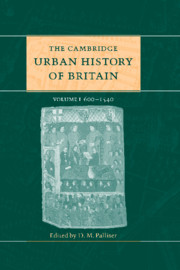Book contents
- Frontmatter
- Part I Introductory
- Part II The early middle ages 600–1300
- Part III The later middle ages 1300–1540
- Part IV Regional surveys
- 21 Regional introduction (England and Wales)
- 22(a) The South-East of England
- 23 Scotland
- Part V Conclusion
- Appendix: Ranking lists of English medieval towns
- Select bibliography
- Index
- References
21 - Regional introduction (England and Wales)
from Part IV - Regional surveys
Published online by Cambridge University Press: 28 March 2008
- Frontmatter
- Part I Introductory
- Part II The early middle ages 600–1300
- Part III The later middle ages 1300–1540
- Part IV Regional surveys
- 21 Regional introduction (England and Wales)
- 22(a) The South-East of England
- 23 Scotland
- Part V Conclusion
- Appendix: Ranking lists of English medieval towns
- Select bibliography
- Index
- References
Summary
Few regions of Europe, certainly in lowland territories, owe their identities solely to inherent characteristics of soil, relief or people. The ecology has been unstable, not least on account of human influence. Long-term cycles in the extent and density of settlement, and some catastrophes, have shaped the ways in which natural resources have been used to best advantage. More intensive use has, through exchange, promoted regional specialism in production and culture, and has generated material and mental infrastructures which can persist through disruptive episodes. Political frameworks, power and tradition are products of those processes and at the same time strongly influence them. Language, for example, is a signifier of local identity which owes as much to politics as to inheritance or migration. Often, the regional boundary markers according to different sets of criteria will not coincide, even in a territory where the physical landscape seems well defined. Moreover, in order to identify the character of a region it is necessary to look beyond it: to other regions within the territory, nation or state, to influences outside that larger space and to the possibility that the region itself may straddle the boundary of that space.
Markets and towns play a central role in the formation of territorial and regional identities, and the following surveys explore that interplay over nine centuries. Overall the period is characterised by growth in the resource base, both human and natural, from a level which was initially very low. That development was interrupted by invasions and natural disasters, occasioning severe demographic setbacks, but there was a continuity to the process which is apparently absent from the transition from late Roman to early medieval times in southern Britain.
- Type
- Chapter
- Information
- The Cambridge Urban History of Britain , pp. 539 - 544Publisher: Cambridge University PressPrint publication year: 2000



